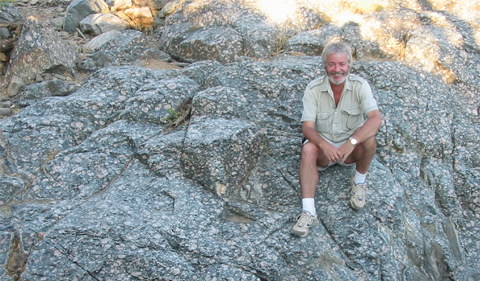
R. Damian Nance
Dr. Damian Nance, Distinguished Professor Emeritus of Geological Sciences at Ohio University, has been invited to give keynotes at major meetings on three continents about an article in which he provides evidence for the existence of Pannotia, a supercontinent predating Pangea by 300 million years. The article garnered widespread interest both here and abroad.
- See “Nance Identifies Hidden Clues to Ancient Supercontinents, Confirms Pannotia” and “Nance: ‘All Hell Breaking Loose on Earth’ Indicates Another Supercontinent 600 Million Years Ago.”
In September, Nance presents his case for Pannotia at the annual meeting of the International Association for Gondwana Research in Xi’An, China, before attending the annual convention of the journal Geoscience Frontiers in Beijing, where he will receive the award for Outstanding Editor.
In October, he travels to Australia to address the Australian Geoscience Council at its inaugural convention in Adelaide. Convened on the theme “Big Issues and Ideas in Geoscience,” it will be the largest geological conference ever held in Australia.
Finally, in November he travels to Indianapolis to address the Geological Society of America in a special session of its annual meeting celebrating the 50th anniversary of the advent of plate tectonics, the paradigm that revolutionized Earth Science.
Although the existence of Pannotia has been difficult to confirm by conventional methods that allow past geographies to be reconstructed, Nance argues that the record of worldwide mountain building and rifting, and the accompanying history of climate change, extinctions and evolutionary radiations, provide unmistakable evidence for the assembly and breakup of a supercontinent about 600 million years ago.
This proxy record is a consequence of the supercontinent cycle, the notion first proposed by Nance and Ohio University colleague Tom Worsley in 1982, when they posited that Earth history has been punctuated by the episodic assembly and breakup of supercontinents.
This idea has recently gained widespread support with the recognition of several past supercontinents and is of paramount importance in geology for two reasons. First, by profoundly influencing the evolution of the Earth’s continents, oceans, atmosphere and biosphere, the cycle has likely affected the rock record more than any other geologic phenomena, and second because its existence documents a fundamental aspect of the planet’s interior dynamics that has charted the course of Earth’s evolution for billions of years.
Armed with the supercontinent cycle, Nance argues that the recognition of past supercontinents need not rely solely on conventional methods, but can also make use of the numerous geologic, climatic and biological proxies with which their assembly and breakup are associated.


















Comments